Implementing a thought leadership strategy in your business is the perfect way for online coaches, consultants, or service providers of any kind, to stand out from the “virtual crowd and noise” which is essential for generating new leads and attracting clients. The goal of a successful thought leadership strategy is for your audience to see you as an expert in your field. But how do you go about it strategically? Keep reading to find out what a thought leadership strategy is and how to implement one in your business.
What is Thought Leadership?
Successful thought leadership is all about positioning yourself as an authority on your expertise area to your audience. It’s about demonstrating to potential clients that you have the knowledge and experience they need to achieve their goals.
When you establish yourself as a thought leader, you become the go-to person for your particular area of expertise. And when you’re the go-to person, lead generation and winning clients becomes a whole lot easier.
Why is Thought Leadership Important?
One of the biggest challenges we are faced with as online entrepreneurs is building our credibility online. Credibility comes down to building trust with your audience. It is important for our audience to see us as the expert in a certain field or industry which is where a thought leadership strategy can help.
If you are like me, you might come from a corporate background where you had high credibility established in a company. People listened to what you had to say, asked you for your insight, requested decisions to be made, and more.
As an online coach, consultant or service provider it can be challenging to gain the same level of credibility.
You can’t just throw your resume on the “virtual table” in hopes that people will read it and respect you.

That’s why thought leadership is so important. It helps you build trust and authority with your audience, potential clients, and within the industry that you are operating in.
TRUST + AUTHORITY = CREDIBILITY
Focusing Thought Leadership on Your Audience
Have you noticed I keep saying “your audience”? I want you to focus on your audience for this strategy because chances are you haven’t even tapped into the potential of your audience.
You will see what I mean shortly.
Two main reasons to focus on your audience
There are two main reasons why you need focus your thought leadership strategy on YOUR audience (to start anyway!).
Your audience may want to engage in work with you
Your audience members ARE PROSPECTS and need to know what you are an expert in! Chances are they have even hired or purchased from someone similar to you because they DID NOT KNOW what you do and who you do it for.
Your audience may know someone who would benefit from working with you
Your audience WILL REFER YOU if they know what you specialize in! This reason is often forgotten and probably the more important of the two! Why? Think about it…if you were looking for help and YOUR friend said “Oh I know someone who can help with X”, are you more likely to engage in work with that person than a random person you found on the internet? Likely so because you TRUST your friend (I hope so anyways!).
Your audience is a powerful tool for your business. Your audience can help you build trust with potential clients, give testimonials to other potential clients, and share the message of your business.
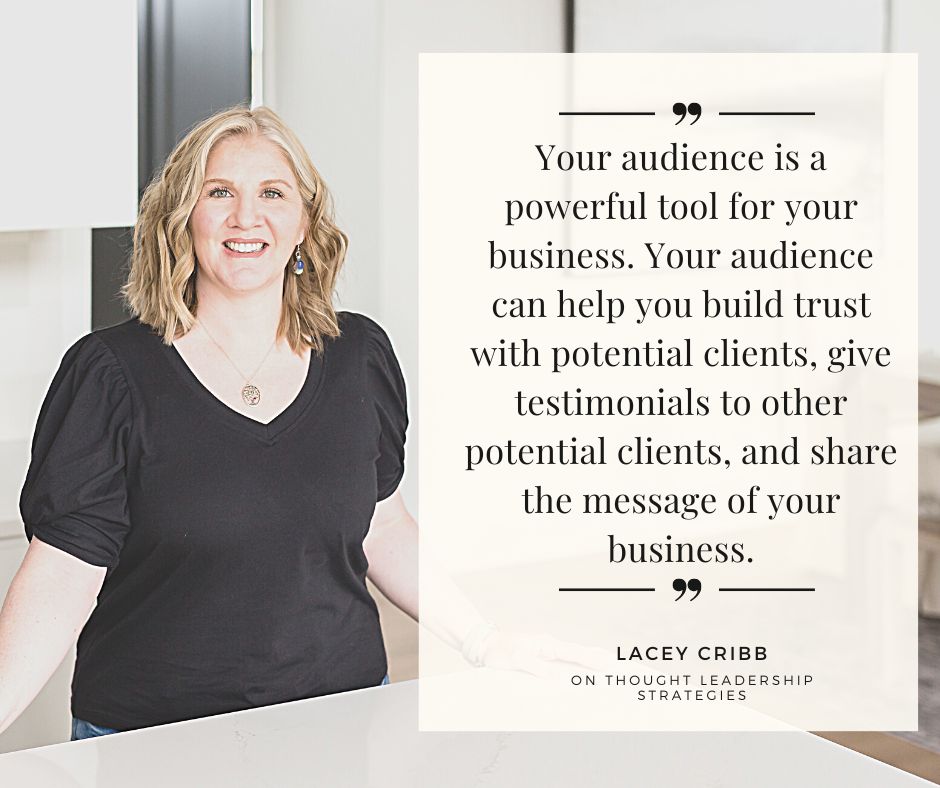
The Payoff from Your Audience
Using regular thought leadership in your content and marketing strategies can expedite building your credibility with your audience. You can maximize the potential of your audience by making sure people know exactly what you do or specialize in and who you do it for.
Implementing a thought leadership strategy can make you HIGHLY REFERABLE.
So much so, you may even want to consider a referral program 😉

How to Implement a Thought Leadership Strategy
So let’s get on to the good stuff and give you a few tips and tricks for implementing thought leadership into your business.
Thought leadership can take many forms from writing and speaking engagement, creating content such as podcasts or articles, participating in online group discussions, doing webinars and workshops. As a thought leader you are bringing value to your audience AND demonstrating your unique knowledge and experience.
Take this one example I did in November 2022. This thought leadership post I shared on Facebook AND LinkedIn does a few things:
- helps my audience understand what I do (strategic planning/email marketing planning) and who I do it for (client with a multiple 6 figure goal)
- lets my audience know I am open for business (have some spots available for a special offer)
- showcases my brain (look at that flowchart ;))

Prerequisites to Implementing a Thought Leadership Strategy
Before, we get too far, I do want to mention a couple prerequisites to Implementing a Thought Leadership Strategy. This means you must complete them, before you move on…
You must have an ideal client / target market
Having a clear idea of who your target market is will help you create messaging that speaks to that audience.
If you need clarity ask yourself:
Who do you want to serve? What type of person are you looking for? What industry are they in, what problems do they need help with?
You must specialize
This should be pretty obvious but you would be surprised at how many people try to be a “jack of all trades”. You need to focus on becoming an expert in ONE area.
Find your niche and own it! Show up as the IT person!
Some questions you can ask yourself to help with this include:
- What is your zone of genius?
- What are you passionate about?
- What do you want to help your clients with?
- What do you enjoy helping clients with?
Why these prerequisites are important
Having a clear idea of who your target market is and what your specialize in will help you determine which thought leadership strategies speak to them and how best to reach them.
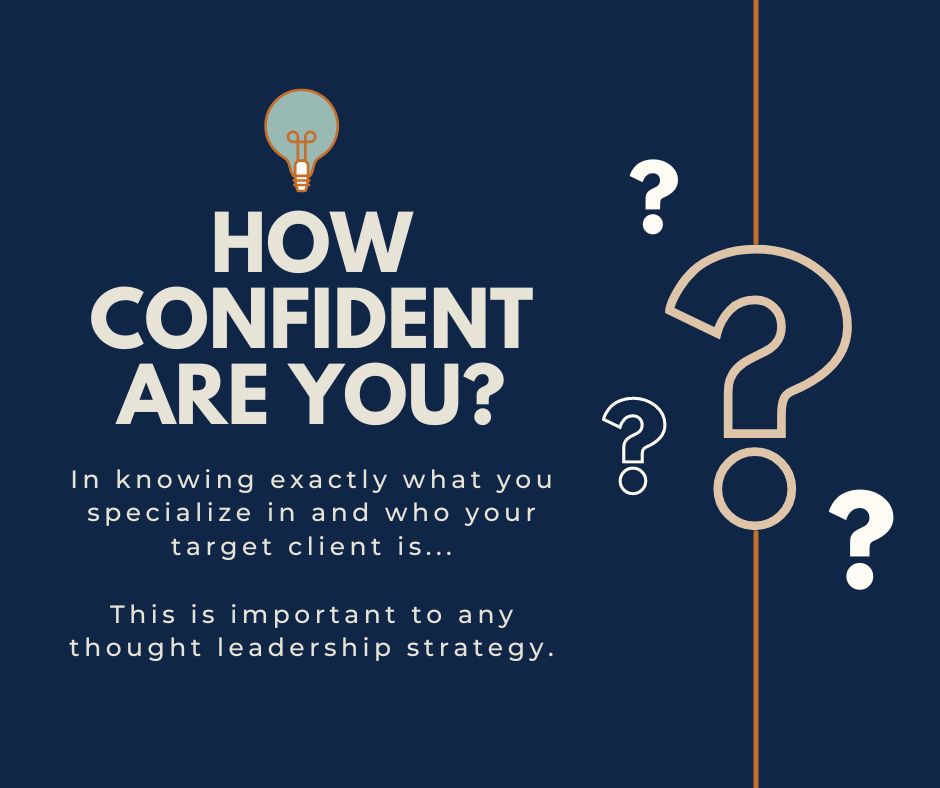
Now that that is out of the way, let’s keep moving!
Creating Content for Your Thought Leadership Strategy
In order to be a thought leader, you need to create content that speaks to your target market. Whether this is in the form of blog posts, podcast episodes, webinars or workshops, articles or interviews – make sure whatever you create adds value to your audience.
You also want to make sure that you are actively engaging with your audience and getting them involved in the conversation. Ask questions, solicit feedback, engage in dialogue with your followers. This will not only help you create better content but it will also allow you to build relationships with those who follow you.

AN ANNOUNCEMENT
It is important for me to say right now, DO NOT TRY ALL OF THESE STRATEGIES AT ONCE! Pick one or even two that feels doable and then implement and play with it/them a little. Try them on, see what fits, and go from there! If you are having trouble deciding between a couple? Focus on the one that will likely have the most impact!
Thought Leadership Content Ideas to get you started
So how do you go about positioning yourself as a thought leader to your audience? Here are a few ideas to get you started…
Write blog posts, newsletters, or emails that showcase your expertise.
Your writing should show off your knowledge and help your readers get a result to a problem. Not only will this position you as an expert in your field, but it will also help you attract quality leads who are interested in what you have to say. Don’t forget to market/share your blog with your audience after you write it. Make a fun graphic for it like the one I made below for my lead magnet and share it back with your audience on social and on your email list. (Click the graphic or this text to grab that freebie!)
Also, don’t rely on people finding your blog organically unless you have engaged in a blog writing strategy with search engine optimization! I’m employing SEO and sharing with my audience to market this blog.
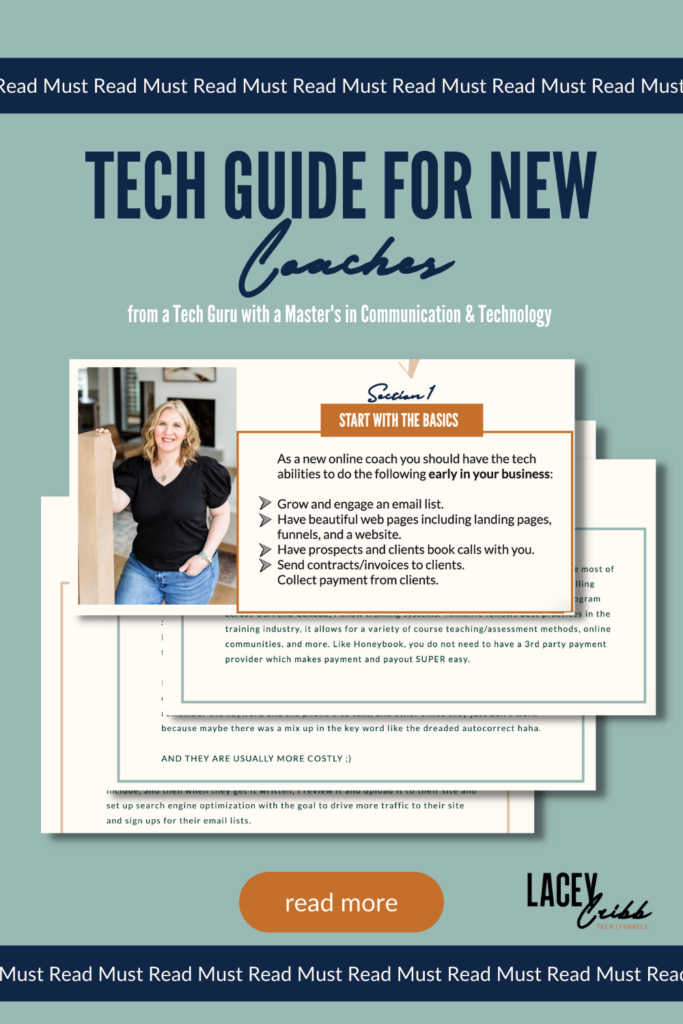
Attend a training or conference in your area of expertise and share your top takeaways with your audience.
People love hearing takeaways from other trainings especially if it was an event or training they wanted to take but just couldn’t make or afford. Exercise your thought leadership by sharing your key takeaways AND add your own flavor to them. Make it extra special by creating and inviting people to an event and let them know exactly what results they can expect by attending.
Get interviewed on a podcast.
Being interviewed on a podcast is a great start to your podcast game. Especially if you have plans to be a host in the future. Research and send podcast pitches to the podcast creator or personal responsible. Note: make sure the podcast targets your ideal audience. AND, where you can really exercise your thought leadership here, is sharing the podcast back to your audience so they can again see you as an expert AND they can share YOU further with their audiences. Expand your reach and referral potential. Check it out. I was interviewed by Kimberly Olson on her Podcast!

Be active on social media platforms.
Social media is a great way to share your thought leadership and increase brand awareness with the world. But it’s not enough to just post random updates—you need to be strategic about it. Go live, share articles and blog posts that showcase your expertise, participate in online discussions, and connect with other thought leaders in your industry. The more engaged you are on social media, the easier it will be for potential clients to find you—and the more they’ll see you as an expert in your field. If you host regular learning and training events that showcase your skills and introduce your offers, make sure you share them on social media. Check out the social media post about a bootcamp I offered. It has 19 comments and was shared 3 times to OTHER PEOPLE’S AUDIENCES. This is the power of your audience!
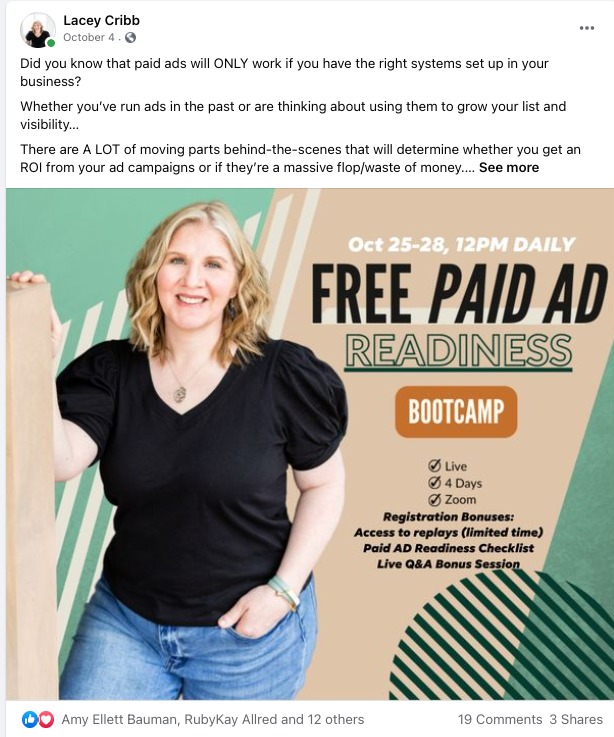
Sharing Your Thoughts on an Article.
If you share (repost) someone else’s blog or article, make sure you add to it. Why did you share it? What are your thoughts on it? Do you agree or disagree? What can you add to it to tell your story? Tip: Research recent news articles in your topic area and share your take. Be seen as someone who is the “the first to know” or first to update. Add a fun graphic or an image of you to the post. Check out this example of a post I shared of Marcus Sheridan’s on LinkedIn. Notice I added my thoughts on it before sharing.
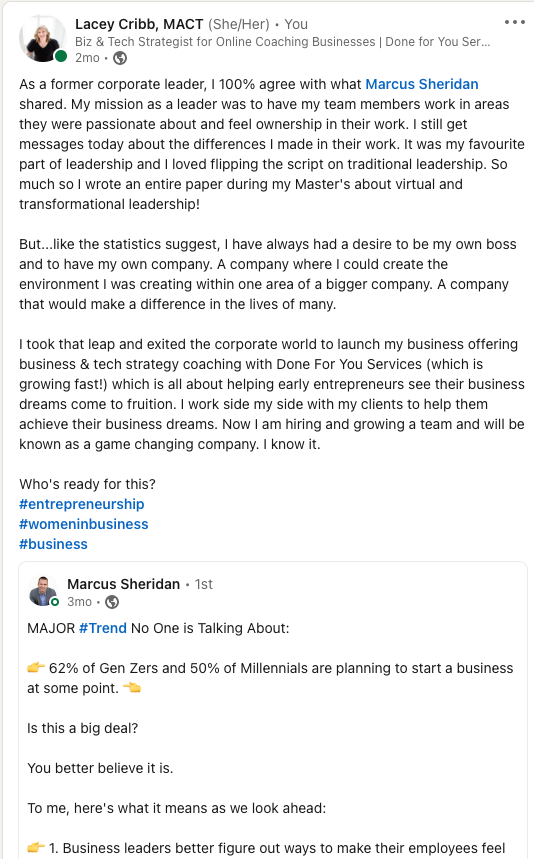
FAQs:
Q: How can I market my blog posts?
A: Share them on social media platforms and other online channels. Make sure you also promote your blog through email marketing campaigns and to level-up create a strategy for search engine optimization (SEO) optimization so people can find it organically.
Q: How can I join relevant online conversations?
A: You can join relevant online conversations by engaging on social media platforms and participating in discussion forums related to your topic area. Share helpful advice, respond to questions, and be an active contributor to the conversations.
Q: How do I find podcast opportunities?
A: Research podcasts that are relevant to your topic area and would be a good fit for your audience. Once you have identified some potential shows, start building relationships with the hosts and pitching ideas that would be interesting to their listeners. You can also look for online job postings related to podcast hosting opportunities or reach out directly to podcast creators who may be looking for guest speakers. Finally, don’t forget to promote your podcast appearances to your own audience.
Q: So many people offer the same coaching services as me. What should I do?
A: It’s true that there is a lot of competition in the coaching industry. However, you can separate yourself from the rest by offering unique services and engaging with your target audience in an authentic way. Focus on being an expert in your field and creating content that communicates your unique point of view. Positioning yourself as a thought leader will help you stand out from the crowd and attract new clients. Additionally, be sure to connect with other coaches in your industry who may offer helpful advice or resources. Collaborate on projects and promote each other’s services – two heads are better than one!
Lastly, have an abundant mindset!
Q: Can I “talk” about other topics outside of my speciality?
A: Keep in mind that it is important to be strategic with the topics you choose to write about/share. The whole point is to build credibility with your audience so they see you as an expert in your field. Choose topics that will help you achieve this goal! If you are a business coach who specializes in helping women entrepreneurs scale their businesses, then make sure your content reflects that! Focus your social media posts, blog articles, freebies, etc. on helping women entrepreneurs scale their businesses.
This doesn’t mean you can never talk about other topics but the majority of your content (80/20 rule) should be focused on your niche. The key is to be strategic with the topics you choose to write about/share. The whole point is to build credibility with your audience so they see you as an expert in your field.
Q: I’m completely new to this…how can I start sharing thought leadership content?
A: If you are new to sharing thought leadership, I would recommend starting with blog articles or social media posts. These are relatively easy to produce and can be a great way to get your feet wet with sharing your expertise with your audience.
Q: I want to expand my thought leadership outside of my audience, what do you suggest?
A: Great question! If you want to expand your thought leadership outside of your current audience, one great way to do this is by leveraging podcasting. Look for podcasts related to your topic area and reach out with an idea for a guest spot. This can be a great way to get more exposure and build relationships in the industry. Additionally, speaking at industry events or joining webinars related to your field can also be a great way to get your voice heard by new people. Other ideas might include:
Collaborate
Another great way to become a thought leader in your industry is by connecting with other leaders in your field for collaboration opportunities. These could be people who have more experience than you or who are at a similar level but have different skillsets. Collaborating with other leaders will not only help improve your own credibility but also expand your reach so that more people are aware of who you are and what you do.
Speak at industry events (locally or virtually).
This is a great way to share your ideas with a wider audience and build credibility with potential clients. Look for events that are relevant to your target market and pitch yourself as a speaker. If you’re not sure where to start, try contacting the organizers of events, local meetups or trade associations in your industry.
Publish a book or white paper.
This shows that you’re not only knowledgeable about your topic but also that you’re able to communicate complex ideas clearly and effectively. Publishing a book or white paper is a great way to attract high-quality leads and close more sales—just make sure that it’s well-written and relevant to your target market!
Become an educator for your favourite tools.
You can do this officially or unofficially. It is no secret I love Honeybook. It is the #1 tool I use in my business. I once wrote a blog post on it (available here: https://laceycribb.com/honeybookpromocode/) AND I did a masterclass on using Honeybook for your business (it is available upon request for a limited time. Just email lacey@laceycribb.com). Helping others use this tool is exciting for me!
Q: What other advice do you have?
A: Don’t be afraid to share your opinion and make sure you add your own unique perspective to the conversations. This will help you stand out as a thought leader in your field.
Bonus Tip: Develop relationships with influencers and thought leaders in your industry to amplify your message and gain more exposure. This could involve networking, attending virtual events, sharing content from those that you admire or even asking for their advice on a topic related to your area of expertise.
By taking the time to build relationships with those who share your interests, you can gain valuable insights and create lasting connections that may benefit your business in the future. Connecting with the right people can open up opportunities for collaborations and other forms of thought leadership that will help you further establish yourself as an expert in your field. So don’t forget to start building those relationships today!
Thought Leadership Self Assessment
Before we close, let’s pause and do a reflection on your business:
How many social media posts on your main social media platform were focused on building your credibility as an expert in the last few weeks?
If your level of thought leadership was was low? Why do you think that was?
Now, here is the better question…What are you going to do about it?
I want you to write down at least one concrete action from this blog post to move on this week or next week to increase your level of thought leadership.
Here are some examples:
- I will create an outline for a white paper or book that I can publish related to my field.
- I will create one social media post per week focused on helping my audience achieve their goals.
- I will reach out to industry associations and pitch myself as a speaker.
- I will search for podcasts related to my topic and reach out with an idea for a guest spot.
Post the action you plan to take in the comments! Writing these down will help ensure that you are taking the necessary steps towards becoming a leader in your field.
Don’t overcomplicate it, just do it!
Summary on Thought Leadership Strategies
Thought leadership is an important part of any marketing strategy—especially if you’re a coach, consultant, or service provider. By positioning yourself as an expert in your field, you can attract high-quality leads, build trust and credibility with potential clients, and close more sales.
Get out there and start positioning yourself as a thought leader today!
Good luck and happy thought leading! 🙂
Don't settle for a mediocre launch game...
Become a launch powerhouse and unleash the full potential of your business.
BOOK A DISCOVERY CALL
© 2024 Launch with Lacey │ Design by Lacey Cribb (yes me!) │ Policies
